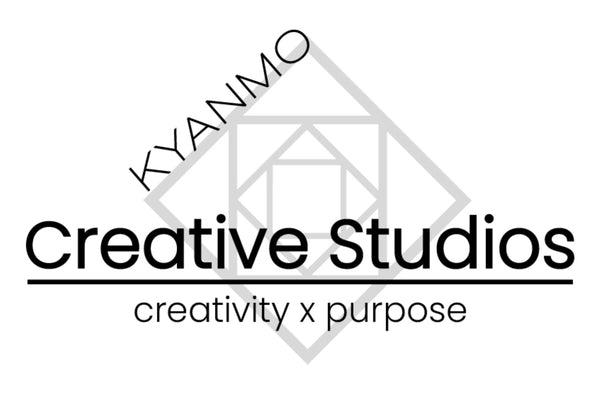Best Practices: Lessons Learned from Real Projects
Share
Running a Creative Studio is one of the most rewarding—and challenging—ventures in the world of design and branding. Over the years at Kyanmo Creative Studios, we’ve celebrated wins, weathered setbacks, and learned countless lessons about what makes a studio thrive. Whether you’re just starting out or looking to refine your agency’s approach, here’s a candid look at common pitfalls and the best practices that can help you avoid them.
1. Pitfall: Neglecting Clear Communication
Lesson Learned:
Early in our journey, we assumed that everyone was “on the same page” after a kickoff call. Inevitably, assumptions led to misunderstandings—missed deadlines, off-brief designs, and frustrated clients.
Best Practice:
· Over-communicate: Document every decision, clarify deliverables, and set expectations from the start.
· Regular Check-ins: Schedule weekly stand-ups or progress updates with both your team and clients.
· Transparent Feedback Loops: Encourage honest, constructive feedback and create safe spaces for team members to voice concerns[1][2].
2. Pitfall: Inconsistent Branding and Messaging
Lesson Learned:
There was a time when our social posts, proposals, and project deliverables looked like they came from three different studios. This inconsistency confused clients and diluted our brand.
Best Practice:
· Brand Guidelines: Develop and enforce clear brand guidelines for visuals, tone, and messaging.
· Consistency Across Touchpoints: Ensure your website, proposals, ads, and social media all reflect the same identity[3][4][5].
· Regular Audits: Periodically review your content and visuals to keep everything aligned.
3. Pitfall: Failing to Test and Iterate
Lesson Learned:
We once launched a major campaign based on gut feeling rather than data. The results? Underwhelming engagement and a hard lesson in the importance of testing.
Best Practice:
· A/B Test Everything: From visuals to copy and calls-to-action, test variations to see what resonates[3][4][5].
· Data-Driven Decisions: Use analytics to guide creative choices, not just intuition.
· Iterate Quickly: Be willing to pivot and refine based on feedback and performance metrics.
4. Pitfall: Overcomplicating Creative Work
Lesson Learned:
In our early days, we believed more was better—more effects, more copy, more visuals. The result was cluttered designs that overwhelmed users.
Best Practice:
· Embrace Simplicity: Focus on a clear message and a single call-to-action[3][4].
· Visual Hierarchy: Guide the viewer’s eye with intentional layout and spacing.
· Authenticity Over Perfection: Authentic, relatable visuals often outperform overly polished ones.
5. Pitfall: Ignoring Team Well-being and Development
Lesson Learned:
Burnout crept in when we prioritized deadlines over our team’s well-being. We lost talented creatives who felt undervalued or overworked.
Best Practice:
· Prioritize Studio Culture: Foster an environment of respect, growth, and recognition[2].
· Invest in Learning: Encourage ongoing education, workshops, and skill-sharing.
· Balance Flexibility and Structure: Offer remote options and flexible hours, but maintain clear processes and accountability.
6. Pitfall: Underestimating the Power of Client Education
Lesson Learned:
Clients sometimes pushed for solutions that weren’t in their best interest. We realized it was our job to guide, not just execute.
Best Practice:
· Educate Clients: Share insights about design trends, branding, and the value of strategy[6][2].
· Set Boundaries: Be clear about what you can (and can’t) deliver, and why.
· Collaborate, Don’t Capitulate: Involve clients in the process, but stand firm on creative decisions that serve their goals.
7. Pitfall: Not Staying Current with Industry Trends
Lesson Learned:
The creative industry evolves quickly. We once lagged behind on new platforms and tools, losing out on opportunities.
Best Practice:
· Continuous Learning: Dedicate time to research, attend conferences, and experiment with new tech[2].
· Encourage Curiosity: Let your team explore and share new ideas or platforms.
· Adapt and Evolve: Be willing to shift your approach as the market and technology change.
Anecdote: Our Turning Point
A few years ago, we took on a high-profile branding project. We skipped some early alignment steps, assuming our vision matched the client’s. Halfway through, we realized we’d missed the mark—costing us time and trust. That experience led us to introduce alignment workshops, regular client check-ins, and a more rigorous feedback process. Since then, our projects have run smoother, our team feels more empowered, and our client satisfaction has soared.
In Conclusion
Running a creative studio is a blend of art, science, and a lot of humility. Mistakes are inevitable, but each one is a stepping stone to better practices. By prioritizing communication, consistency, testing, simplicity, team well-being, client education, and adaptability, your studio can avoid common pitfalls and build a reputation for excellence.
What lessons have you learned in your creative journey? Share your stories or questions in the comments—we’re in this together.
1. https://www.manyrequests.com/blog/project-management-best-practices
2. https://www.creativeboom.com/insight/the-biggest-challenges-for-design-studios-in-2025-and-how-leaders-plan-to-tackle-them/
3. https://www.taboola.com/marketing-hub/best-creative-practices/
4. https://nogood.io/2025/01/17/meta-creative-best-practices/
5. https://leadsbridge.com/blog/meta-ads-best-practices/
6. https://focuslab.agency/blog/creative-agencies-in-2025-trends-advice-and-whats-next
